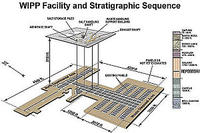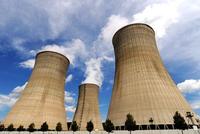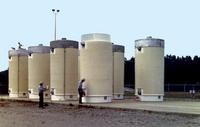-
Testing the shelf-life of nuclear reactors’ components
The structural components of advanced reactors such as the sodium fast reactor and the traveling wave nuclear reactor must be able to withstand the extreme levels of radioactivity from the fission reaction itself at temperatures well above 400 Celsius. Unfortunately, standard tests of such components are expensive, require increasingly rare test reactors and test periods that are impractical. Researchers have devised a quick way to test the structural materials used to build nuclear reactors by using high-energy beams of charged particles (ions).
-
-
Hopes for quicker, cheaper ways to build nuclear power plants dim
Promises of building a more cost effective U.S. nuclear industry continue to face setbacks as alternative energy sources like natural gas become cheaper for utilities, while new models for nuclear plants face cost overruns.Nuclear reactor developers sought to build new plants using prefabricated Lego-like blocks to save time and reduce labor costs, butanalysts consider the designs for the new nuclear reactors to be difficult or impossible to build.
-
-
U.S. nuclear plant licensees should seek, act on nuclear plant hazards information
A new report concludes that the overarching lesson learned from the 2011 Fukushima Daiichi nuclear accident is that nuclear plant licensees and their regulators must actively seek out and act on new information about hazards with the potential to affect the safety of nuclear plants. The committee that wrote the report examined the causes of the Japan accident and identified findings and recommendations for improving nuclear plant safety and offsite emergency responses to nuclear plant accidents in the United States.
-
-
DOE chief to visit WIPP to discuss funding for recovery efforts

Energy Secretary Ernest Moniz will visit Carlsbad, New Mexico on 12 August to discuss funding for the Waste Isolation Pilot Plant (WIPP) recovery efforts.Traces of americium and plutonium were released from a nuclear waste drum on 14 February and were detected in the air almost a half-mile outside WIPP. On 15 May, the DOE confirmed that the damage occurred on a waste drum from Los Alamos National Laboratory.
-
-
Fire shuts down nuclear repository, but DOE still recognizes operator for “excellent” performance
Five days after an underground truck fire closed the Waste Isolation Pilot Plant (WIPP), the Energy Department (DOE) awarded Nuclear Waste Partnership (NWP), the operating contractor of the nuclear repository, $1.9 million for “excellent” performance during the past year.Shortly after the truck fire, WIPP was shut down because of radiation leak, Still, “No federal or contractor official has lost their job, been transferred, been moved off the WIPP contract or otherwise held accountable. No leadership has changed at the federal level. No company has lost a contract,” noted an industry observer.
-
-
Japan testing underground nuclear waste storage depot, despite local concerns
Data is being collected at the Horonobe Underground Research Center, in Horonobe, Japan to determine whether the site is able to begin storing radioactive waste in conditions which could last for 100,000 years.Japanese utility systems have produced more that 17,000 tons of “spent” nuclear fuel rods from power plants which are no longer useful but are expected to remain radioactive for around several thousand years.
-
-
Los Alamos lab admits mishandling toxic waste, causing repository radiation leak
In a letter addressed to the New Mexico Environment Department (NMED), lab officials at Los Alamos National Laboratory (LANL) have admitted to mishandling toxic waste shipped to the Waste Isolation Pilot Plant (WIPP) in Carlsbad, New Mexico, the nation’s only permanent repository for plutonium-contaminated waste from government nuclear facilities.
-
-
As Baby Boomers retire, nuclear industry faces manpower shortages
Many nuclear power plants in the United States are facing an employment and training crisis as their largely Baby Boomer-generation (1946-64) workforce begins to retire. The nuclear industry is making an effort to usher in new and better-trained workers — many from university programs and former military service — to fill in the gaps created by retirement-aged engineers.
-
-
Making nuclear power plants more resilient during earthquakes
Researchers in Finland are examining current nuclear power plants’ structure to see where improvements could be made to make them more resilient during earthquakes. Finland currently is building new nuclear power plants, and within ten years, the country expects to be getting 60 percent of its electricity from nuclear plants.
-
-
Using cosmic rays to peer inside Fukushima Daiichi reactors
Muon radiography (also called cosmic-ray radiography) uses secondary particles generated when cosmic rays collide with upper regions of Earth’s atmosphere to create images of the objects that the particles, called muons, penetrate. The process is analogous to an X-ray image, except muons are produced naturally and do not damage the materials they contact. Los Alamos National Laboratory the other day announced an impending partnership with Toshiba Corporation to use muon tomography safely to peer inside the cores of the Fukushima Daiichi reactors and create high-resolution images of the damaged nuclear material inside without ever breaching the cores themselves. The initiative could reduce the time required to clean up the disabled complex by at least a decade and greatly reduce radiation exposure to personnel working at the plant.
-
-
Carbon-cutting regulations may boost prospects of nuclear power plants

In a report issued last Thursday, Standard & Poor’s Ratings Services (S&P) predicted that new nuclear plant construction could benefit from the Environmental Protection Agency’s (EPA) recent carbon-cutting guidelines for current natural gas power plants.
-
-
NNSA says security at Y-12 National Security Complex has improved
Retired Air Force lieutenant-general and now National Nuclear Security Administration(NNSA) chief Frank Klotz asserted last week that security at the Y-12 National Security Complexat Oak Ridge National Laboratory(ORNL) has improved significantly since a 28 July 2012 break-inat the plant when three aging peace activists, led by an 82-year old nun, managed to breach the facility’s supposedly impregnable perimeter security systems.
-
-
NRC will not require nuclear plants to transfer waste to dry cask storage

Cooling pools on the grounds of U.S. nuclear plants, where toxic nuclear waste is stored, are near capacity, and in 2010 the plug was pulled on the Yucca Mountain centralized national nuclear waste repository, meaning that for the foreseeable future radioactive will continue to accumulate on site at the more than 100 nuclear power plants. Lawmakers called on the U.S. Nuclear Regulatory Commission (NRC) to require nuclear plants to hurry the transfer of spent fuel from the cooling pools to dry cask storage, which scientists consider much safer. The NRC, however, has decided that, at least for now, there is now reason to require nuclear plants to do so.
-
-
Critics: U.K. nuclear watchdog plagued by “indefensible” conflicts of interest
Britain’s nuclear watchdog, the Office for Nuclear Regulation(ONR), is receiving technical advice from companies it is tasked with monitoring, leading industry insiders to accuse the watchdog of accepting advice tainted with “unbelievable” conflicts of interest. ONR’s chairman, Nick Baldwin, noted that the agency is concerned about possible conflicts of interest, but that there is a “small gene pool” of firms capable of advising ONR inspectors.
-
-
Guard fired for Y-12 breach says he was made a scapegoat for contractor’s failings
Kirk Garland, a security guard at the Y-12 National Security Complex in Oak Ridge, Tennessee, was fired from his job two weeks after three aging peace activists, led by an 82-year old nun, managed, on 28 July 2012, to breach the facility’s supposedly impregnable perimeter security systems, then loiter, unnoticed, on the grounds of the facility, where bomb grade uranium is stored. The activists had enough time to spray-paint peace messages and Bible verses on walls, slosh the walls with human blood, and wrap one of the buildings with crime-scene tape. In an arbitration hearing, Garland argued that he was made a scapegoat for the larger failings of the then-security contractor,Wackenhut Services.
-